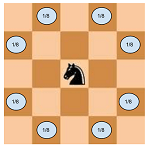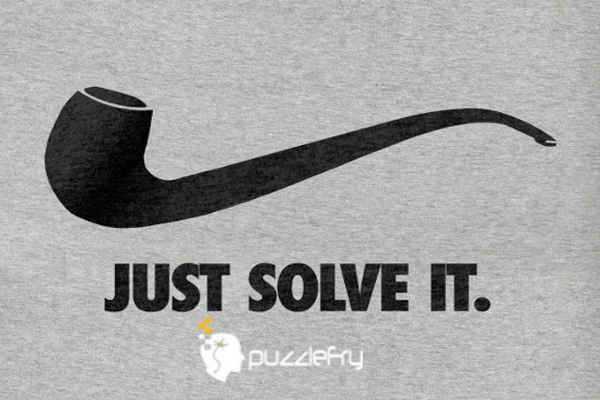Knight on a Chess Board
Given the size of the chess board and initial position of the knight, what is the probability that after k moves the knight will be inside the chess board.
Note:-
1) The knight makes its all 8 possible moves with equal probability.
2) Once the knight is outside the chess board it cannot come back inside.

Puzzlefry added Info-
This challenge is originally from a blog post of crazyforcode.com published under the CC BY-NC-ND 2.5 IN licence.
After removing mirror images, there are six unique positions on the board: (1,1), (1,2), (1,3), (2,2), (2,3), (3,3). The knight starts at (3,3).
From each position, there is a fixed probability of moving to each of the other five positions. The probability of moving off the board is 1 minus the sum of the probabilities of moving to other board positions.
. -------- starting position -------- . (1,1) (1,2) (1,3) (2,2) (2,3) (3,3) (1,1) .250 (1,2) .250 .250 1.000 (1,3) .125 .250 (2,2) .125 .250 (2,3) .250 .250 .250 (3,3) .125
A quick examination reveals that positions (1,3) and (2,2) are equivalent–they each have the same probability for the following square. So we can collapse them into a single state we’ll label as (*,*), giving the following five position table.
. ----- starting position ----- . (1,1) (1,2) (*,*) (2,3) (3,3) (1,1) .250 (1,2) .250 1.000 (*.*) .250 .500 (2,3) .250 .250 (3,3) .125
The probability for the knight to be in each of the five positions at the end of k moves is the sum of the product of probability of the knight moving to that position from another position and the probability of having been in that position at the end of k-1 moves. At zero moves, the probability of being in position (3,3) is 1 and the probability of being elsewhere on the board is 0. After each move, the probability of the knight having moved off the board is 1 minus the sum of the probabilities of it being in each position.
k (1,1) (1,2) (*,*) (2,3) (3,3) Off board 0 1.00000 1 1.00000 2 0.25000 0.12500 0.62500 3 0.18750 0.06250 0.75000 4 0.01563 0.07813 0.02344 0.88281 5 0.04297 0.02344 0.93359 6 0.00586 0.02246 0.00537 0.96631 7 0.01099 0.00708 0.98193 8 0.00177 0.00629 0.00137 0.99057 9 0.00294 0.00201 0.99504 10 0.00050 0.00174 0.00037 0.99739
ALGORITHM:
Start with the initial coordinates of the knight.
Make all possible moves for this position and multiply these moves with their probability, for each move recursively call the function continue this process till the terminating condition is met. Terminating condition is if the knight is outside the chess board, in this case return 0, or the desired number of moves is exhausted, in this case return 1.
As we can see that the current state of the recursion is dependent only on the current coordinates and number of steps done so far. Therefore we can memorize this information in a tabular form.
For better understanding and Computer program of the algo – crazyforcode.com
Your Answer
More puzzles to try-

What is the logic behind these ?
3 + 3 = 3 5 + 4 = 4 1 + 0 = 3 2 + 3 = 4 ...Read More »
Defective stack of coins puzzle
There are 10 stacks of 10 coins each. Each coin weights 10 gms. However, one stack of coins is defective ...Read More »
Which clock works best?
Which clock works best? The one that loses a minute a day or the one that doesn’t work at all?Read More »
(Advanced) Cheryl’s Birthday Puzzle
Paul, Sam and Dean are assigned the task of figuring out two numbers. They get the following information: Both numbers ...Read More »
Five greedy pirates and gold coin distribution Puzzle
Five puzzleFry ship’s pirates have obtained 100 gold coins and have to divide up the loot. The pirates are all ...Read More »
Magical flowers!!
A devotee goes to three temples, temple1, temple2 and temple3 one after the other. In front of each temple, there ...Read More »
Tuesday, Thursday what are other two days staring with T?
Four days are there which start with the letter ‘T‘. I can remember only two of them as “Tuesday , Thursday”. ...Read More »
How could only 3 apples left
Two fathers took their sons to a fruit stall. Each man and son bought an apple, But when they returned ...Read More »
How Many Eggs ?
A farmer is taking her eggs to the market in a cart, but she hits a pothole, which knocks over ...Read More »
HARD MATHS – How much faster is one train from other Puzzle
Two trains starting at same time, one from Bangalore to Mysore and other in opposite direction arrive at their destination ...Read More »
Most Analytical GOOGLE INTERVIEW Question Revealed
Let it be simple and as direct as possible. Interviewer : Tell me how much time (in days) and money would ...Read More »
Lateral thinking sequence Puzzle
Solve this logic sequence puzzle by the correct digit- 8080 = 6 1357 = 0 2022 = 1 1999 = ...Read More »
How did he know?
A man leaves his house in the morning to go to office and kisses his wife. In the evening on ...Read More »
Pizza Cost Math Brain Teaser
Jasmine, Thibault, and Noah were having a night out and decided to order a pizza for $10. It turned out ...Read More »
Which letter replaces the question mark
Which letter replaces the question markRead More »
Which room is safest puzzle
A murderer is condemned to death. He has to choose between three rooms. The first is full of raging fires, ...Read More »
Richie’s Number System
Richie established a very strange number system. According to her claim for different combination of 0 and 2 you will ...Read More »
Srabon wanted to pass
The result of math class test came out. Fariha’s mark was an even number. Srabon got a prime!! Nabila got ...Read More »
Become Normal!!
Robi is a very serious student. On the first day of this year his seriousness for study was 1 hour. ...Read More »
Sakib Knows The Number!
Ragib: I got digits of a 2 digit number Sakib: Is it an odd? Ragib: Yes. Moreover, the sum of ...Read More »



